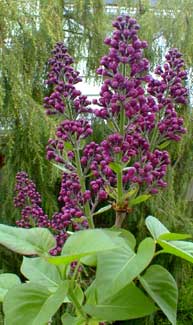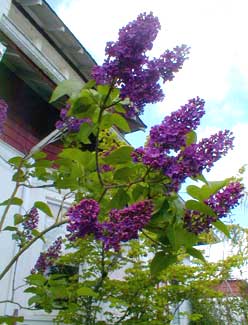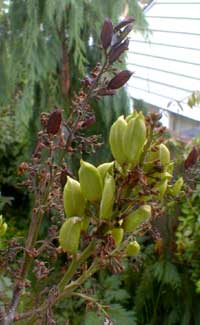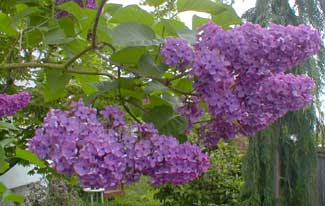
Dark Purple Common Lilac
Now that the lilacs are in bloom,
she keeps a bowl of lilacs in her room
And twists one in his fingers while she talks.
"Ah my friends,
you do not know, you do not know
What life is, you who hold it in your hands";
(Slowly twisting the lilac stalks)
"You let it flow from you, you let it flow,
And youth is cruel, & has no remorse
And smiles at situations which it cannot see."
I smile, of course,
And go on drinking tea.
-T. S. Eliot
(1888-1965)
(1888-1965)
Our neighbor Sue has two large lilac trees (Syringa vulgaris) that were planted by her mother when her parents owned the house a generation ago. She came over one day & asked us if we wanted to have one of the suckering shrubs that had sprung up under one of these trees. We sure would!
 It was harder than the devil to dig up because the root was not nearly as small as the shrub itself. Actually, the shrub wasn't exactly small. It was about nine feet tall. But it consisted of just two main limbs, one about head-high, the other tall indeed, a largely naked upright stem with a fluff of leaves on top. It had grown slender & leggy, straight-upward, striving to find access to sunlight through the thickly overhanging parent.
It was harder than the devil to dig up because the root was not nearly as small as the shrub itself. Actually, the shrub wasn't exactly small. It was about nine feet tall. But it consisted of just two main limbs, one about head-high, the other tall indeed, a largely naked upright stem with a fluff of leaves on top. It had grown slender & leggy, straight-upward, striving to find access to sunlight through the thickly overhanging parent.There were other suckered specimens to choose from, but I liked this tall gangly thing best. I thought it would look just right at the corner of our raised deck, as the slender plant was tall enough to be seen from up on the deck, & we would be able to take in its wonderful perfume just outside the door.
After I transplanted it at the deck's corner, it was pretty shocked about the move, & its leaves hung wilted for a week or more, & I worried about it some, but it soon enough livened up.
The following April & May (of 2002), it bloomed way up at the top, which was the only bushy part, above the otherwise nearly naked main limb.
 I said at the time, "If it also blooms next year, we will be very lucky." Lucky because lilacs typically stop blooming for a couple of years after the shock of transplant, while they work on putting down good roots. They may bloom their first year merely because they already had buds set from before they experienced a shock.
I said at the time, "If it also blooms next year, we will be very lucky." Lucky because lilacs typically stop blooming for a couple of years after the shock of transplant, while they work on putting down good roots. They may bloom their first year merely because they already had buds set from before they experienced a shock.In spring 2003 my prediction proved true. The tall slender start of a lilac tree was suckering & leafing out wonderfully, but it had set no buds the previous year, so it did not bloom. Happily, we nevertheless had plenty of lilacs anyway, thanks to the row of S. vulgaris 'White' that our back-yard-neighbor planted right on the property-line, so long ago they are a good fifteen feet tall & as flowery as big lilacs tend to be!
By its third spring (2004) the shrub had not only gotten many more branches, but it produced a great many more flowers than I expected. As a gangly shrub under its parent it hadn't gotten its fair share of light, but in its new home beside our deck, it had full morning sun & set scads of buds. It was great it only skipped one year of flowering after the shock of having its roots hacked from its parent.
The first two photos on this page are from early April & mid-April respectively, & the fourth photo in late April. The buds on the first photo are not yet opened but already huge & beautiful. The first photo was snapped standing on the upper deck to the back door. The second was snapped from the ground, looking up at the sky. The third photo shows ripened lilac seeds in August.
Lilacs come in many colors from white to pink to pale lilac to blue to dark purple. This variety is the darkest purple-lilac, & is in fact closest to the natural color of the wild form.
 There are a number of old cultivars in this dark color range, such as 'A. B. Lamberton' & 'Adelaide Dunbar' both dating to 1916, 'A. M. Brand' dating to 1953, & 'Albert the Good' dating to 1874, & many others I wouldn't be able to tell apart, so I'm not likely to know this one as anything but Deep Dark Purple.
There are a number of old cultivars in this dark color range, such as 'A. B. Lamberton' & 'Adelaide Dunbar' both dating to 1916, 'A. M. Brand' dating to 1953, & 'Albert the Good' dating to 1874, & many others I wouldn't be able to tell apart, so I'm not likely to know this one as anything but Deep Dark Purple.Our narrow twig of a lilac has become quite an interesting tall narrow shrub. After so few years it is still of course "nothin' much" compared to the two huge & beautiful parent trees next door. But I love this tall slender youngster much more than any compact & bushy commercially prepared plant; & I love that its parents have been in the neighborhood for decades.
The genus name Syringa is after Syrinx, an Arcadian virgin nymph of Artemis who looked like Artemis in appearance & manner. Originally Syrinx was not the genius of the lilac bush that today bares her name, but of hollow reeds that grow in marshes & along riverbanks. Just such hollow reeds were bound together to make the original panpipes, which were called syrinx. In time time the nymph Syrinx became identified as the genius of any plant the stems of which could be used to make tubes. Thus the German engraving from the early 1600s, as shown on this page, depicts Pan clinging not to reeds, but to the stump of a tree. Although lilac twigs are not hollow, they have a soft inner pulp that was easily drilled out, so that lilac limbs were traditionally hollowed out to make flutes or pipestems.
 In the myth of Syrinx, the woodland god Pan spied Syrinx as she was hunting upon Mount Lycaeus with her bow made of horn. He pursued the fleet-footed nymph with his satyr's lust. She had always found it easy to avoid the ordinary satyrs, but Pan being also a god was able to close the distance between them. Her fellow naiads included among their numbers Daphne (who in a similar myth was transformed into a laurel tree), Thelpousa (tutelary goddess of the Arcadian town that bore her name), Metope (whose daughter Thebe was abducted by Zeus, & made her a mistress of horses & a warrior-queen in Thebes), & Themis (who was loved by Hermes, & was the ancestral goddess of the Arcadian royal house of Euander), & other daughters of the River-god Ladon whose names are not preserved. When she had fled as far as the river Ladon, she cried out to her watery sisters. Upon the moment of Pan's unwanted embrace, she was transformed into water-reeds in order to escape the god's desire. Pan, finding himself clutching not a beautiful naiad, but only reeds, sighed with deep mournfulness, & his breath produced a sound from the reeds, which he subsequently bound together to form the first panpipes.
In the myth of Syrinx, the woodland god Pan spied Syrinx as she was hunting upon Mount Lycaeus with her bow made of horn. He pursued the fleet-footed nymph with his satyr's lust. She had always found it easy to avoid the ordinary satyrs, but Pan being also a god was able to close the distance between them. Her fellow naiads included among their numbers Daphne (who in a similar myth was transformed into a laurel tree), Thelpousa (tutelary goddess of the Arcadian town that bore her name), Metope (whose daughter Thebe was abducted by Zeus, & made her a mistress of horses & a warrior-queen in Thebes), & Themis (who was loved by Hermes, & was the ancestral goddess of the Arcadian royal house of Euander), & other daughters of the River-god Ladon whose names are not preserved. When she had fled as far as the river Ladon, she cried out to her watery sisters. Upon the moment of Pan's unwanted embrace, she was transformed into water-reeds in order to escape the god's desire. Pan, finding himself clutching not a beautiful naiad, but only reeds, sighed with deep mournfulness, & his breath produced a sound from the reeds, which he subsequently bound together to form the first panpipes.The lilac bush was also believed to grow in Hades, & had associations of the night. The common name Lilac is from the Persian Lila, a common girls' name meaning "Evening," apropos of dark purple lilacs being the color of night. It is also more or less the same meaning as Lilith, "Night," & lilac extract is an old ingredient in spell-casting among voudon practitioners, so that lilac's associations with the Night -- from the wedding bed to cemeteries -- are numerous.
In the Dionysiaca, grief-stricken Pan's first song of grief upon the syrinx was to the goddess Cythereia, i.e., Aphrodite. In later folk belief, the lilac was associated with love. To test whether the object of one's affection returned such feelings, five lilac petals were to be eaten in succession; if it could be done without a petal getting stuck in the throat, then one's lover was true. Or a well-budded cutting of a lilac limb should be brought into the house late in autumn; if it can be induced to bloom by Christmas day, then one's intended marriage was vouchsafed a good match.
At the same time, lilacs became associated with death, & is one of the most common trees encountered in old cemeteries. The association may have come about because sweetly-scented flowers were used to surround the dead while they lay in state, to mask the odor of decaying flesh. Also, pale purple was once considered the color of mourning garments, the same as wearing black.
A final bit of lilac folklore must be prefaced with this old traditional ballad:
"Green grow the lilacs, all sparkling with dew.The ballad became the basis of a bit of Urban Folklore that trumped up an etymological origin to the word "Gringo." Purportedly, during the Spanish American War, so many Spanish-speaking soldiers overheard American soldiers singing "Green grow the lilacs" that they began calling Americans "Gringos."
I'm lonely, my darling, since parting with you,
And by the next meeting, I hope to prove true
And change the green lilacs to the red, white, & blue."